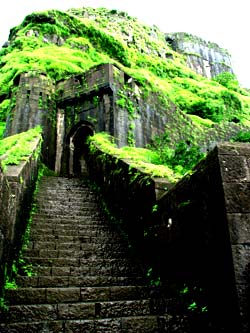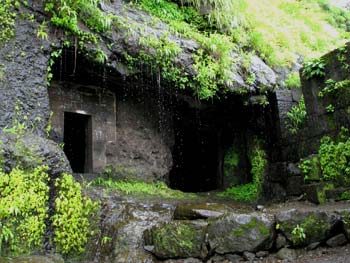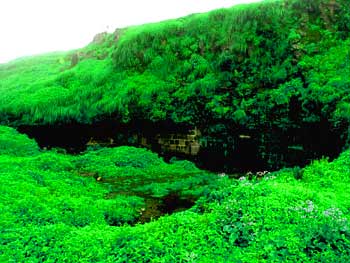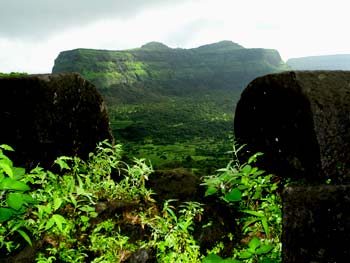 Lohagarh, as the name suggests is an iron fort, soaked in history. The bastion stands aggressively amidst the Sahyadris near Lonavala. In the monsoon the fort is veiled in mist, brilliant green foliage lines the route and waterfalls punctuate the verdant hill sides; making a trek to the fort at this time a wonderful experience. Lohagarh, as the name suggests is an iron fort, soaked in history. The bastion stands aggressively amidst the Sahyadris near Lonavala. In the monsoon the fort is veiled in mist, brilliant green foliage lines the route and waterfalls punctuate the verdant hill sides; making a trek to the fort at this time a wonderful experience.The trek starts at Malavali railway station, when coming here by train; and Bhaje Village if arriving by road. The climb begins at Bhaje, the route being a rubble track to a plateau at the base of, and between the twin forts of Lohagarh � Visapur. To get here takes about an hour of easy climbing. At this point one needs to decide which fort to climb to. Lohagarh being better preserved, the easier climb is recommended. | |||||
 Another small village, Lohadwadi, is situated in the depression between Lohagarh and Visapur, this is really a collection of vendors selling food and drink at the base of the fort. The climb up the steps is easy, with spectacular panoramic views along the way. The fort walls are in good repair and it is easy to discern the three layers of defenses marked by walls. The precision workmanship and fine finish of the stone blocks used in the fort walls are noteworthy, fitted together without cement or any other discernible adhesive. The steps are mostly in good shape, however at places they have eroded due to rain water and small water streams, and it is wise to be cautious at these places as the surfaces are slick with moss. Vichhu Kata. At the top there is not much by way of fortifications but the expanse is large and over interesting undulating terrain. The functionality of the walls and the absence of architectural embellishments within the fort perimeter indicates that these were austere fighting bastions and not fort-palaces as is common elsewhere in the country. The many ancient underground cisterns and the stepped bawdi (tank) used for water storage shows the meticulous planning of the ancient warriors to ensure they did not run out of water during a siege. Another small village, Lohadwadi, is situated in the depression between Lohagarh and Visapur, this is really a collection of vendors selling food and drink at the base of the fort. The climb up the steps is easy, with spectacular panoramic views along the way. The fort walls are in good repair and it is easy to discern the three layers of defenses marked by walls. The precision workmanship and fine finish of the stone blocks used in the fort walls are noteworthy, fitted together without cement or any other discernible adhesive. The steps are mostly in good shape, however at places they have eroded due to rain water and small water streams, and it is wise to be cautious at these places as the surfaces are slick with moss. Vichhu Kata. At the top there is not much by way of fortifications but the expanse is large and over interesting undulating terrain. The functionality of the walls and the absence of architectural embellishments within the fort perimeter indicates that these were austere fighting bastions and not fort-palaces as is common elsewhere in the country. The many ancient underground cisterns and the stepped bawdi (tank) used for water storage shows the meticulous planning of the ancient warriors to ensure they did not run out of water during a siege. A walk around the top shows a few ancient temples and dargas in varying states of repair and the breathtaking views in all directions. The vivid green panoramas of the rain soaked Sahyadris are truly beautiful. A walk to the Vinchu - Kata (scorpion's sting), so called because of its shape, rewards one with a grandstand view of Visagarh opposite. The Vinchu - Kata was an extension of the fort which was used as a look out, and as a line of defense in ancient days. During the monsoons due to the narrow, slippery path and strong winds, care is advised. During the rains there is a constant mist and fine drizzle at the top and one has to wait for gaps to enjoy the scenic beauty. While descending from the fort the slippery rocks can be tricky.Within a kilometer of Lohadgarh the climb to the twin fort of Visagarh begins. The history of these forts is intriguingly interlinked as they constantly changed hands and one fort acted as the counter to the other. The climb to Visagarh is more arduous and tricky, but more about it in another article. A walk around the top shows a few ancient temples and dargas in varying states of repair and the breathtaking views in all directions. The vivid green panoramas of the rain soaked Sahyadris are truly beautiful. A walk to the Vinchu - Kata (scorpion's sting), so called because of its shape, rewards one with a grandstand view of Visagarh opposite. The Vinchu - Kata was an extension of the fort which was used as a look out, and as a line of defense in ancient days. During the monsoons due to the narrow, slippery path and strong winds, care is advised. During the rains there is a constant mist and fine drizzle at the top and one has to wait for gaps to enjoy the scenic beauty. While descending from the fort the slippery rocks can be tricky.Within a kilometer of Lohadgarh the climb to the twin fort of Visagarh begins. The history of these forts is intriguingly interlinked as they constantly changed hands and one fort acted as the counter to the other. The climb to Visagarh is more arduous and tricky, but more about it in another article. In the vicinity of the base village are the famous Bhaje Leni (caves), these are reached by a short climb up steps from Bhaje Village. The well preserved carving of these ancient Buddhist caves into the rock face of the mountain framed in waterfalls is definitely worth a visit.If one is energetic and fit it is possible to take in both the forts and the Bhaje Leni in a day, but for the less physically inclined, a walk up to Lohagad and a side track up to the caves would make for a lovely day out in the rains. In the vicinity of the base village are the famous Bhaje Leni (caves), these are reached by a short climb up steps from Bhaje Village. The well preserved carving of these ancient Buddhist caves into the rock face of the mountain framed in waterfalls is definitely worth a visit.If one is energetic and fit it is possible to take in both the forts and the Bhaje Leni in a day, but for the less physically inclined, a walk up to Lohagad and a side track up to the caves would make for a lovely day out in the rains. | |||||
Saturday, 11 October 2014
Trek to Lohgarh Fort
Labels:
Bhaje,
history,
Lohgarh,
Lonavala,
Maharashtra forts,
Malavali,
Sahyadri,
trek,
trekking,
Vichhu Kata,
wilderness
Subscribe to:
Post Comments (Atom)
No comments:
Post a Comment